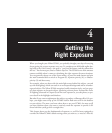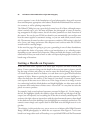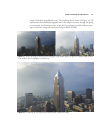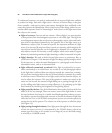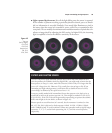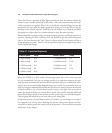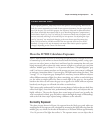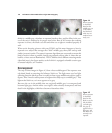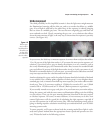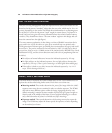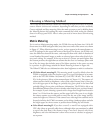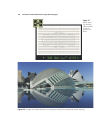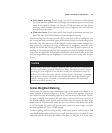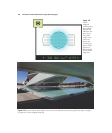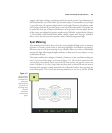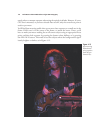
Underexposed
The third possibility in this simplified scenario is that the light meter might measure
the illumination bouncing off the white cat, and try to render that feline as a middle
gray. A lot of light is reflected by the white kitty, so the exposure is reduced, bringing
that cat closer to a middle gray tone. The cats that were originally gray and black are
now rendered too dark. Clearly, measuring the gray cat—or a substitute that reflects
about the same amount of light, is the only way to ensure that the exposure is precisely
correct. (See Figure 4.6.)
Chapter 4 ■ Getting the Right Exposure 103
Figure 4.6
When expo-
sure is calcu-
lated based on
the white cat
on the right,
the other two
cats are under-
exposed.
As you can see, the ideal way to measure exposure is to meter from a subject that reflects
12 to 18 percent of the light that reaches it. If you want the most precise exposure cal-
culations, if you don’t have a gray cat handy, the solution is to use a stand-in, such as
the evenly illuminated gray card I mentioned earlier. But, because the standard Kodak
gray card reflects 18 percent of the light that reaches it and, as I said, your camera is cal-
ibrated for a somewhat darker 12-percent tone, you would need to add about one-half
stop more exposure than the value metered from the card.
Another substitute for a gray card is the palm of a human hand (the backside of the hand
is too variable). But a human palm, regardless of ethnic group, is even brighter than a
standard gray card, so instead of one-half stop more exposure, you need to add one addi-
tional stop. That is, if your meter reading is 1/500th of a second at f/11, use 1/500th
second at f/8 or 1/250th second at f/11 instead. (Both exposures are equivalent.)
If you actually wanted to use a gray card, place it in your frame near your main subject,
facing the camera, and with the exact same even illumination falling on it that is falling
on your subject. Then, use the spot metering function (described in the next section)
to calculate exposure. Of course, in most situations, it’s not necessary to do this. Your
camera’s light meter will do a good job of calculating the right exposure, especially if
you use the exposure tips in the next section. But, I felt that explaining exactly what is
going on during exposure calculation would help you understand how your D7000’s
metering system works.
To meter properly you’ll want to choose both the metering method (how light is evalu-
ated) and exposure method (how the appropriate shutter speeds and apertures are cho-
sen). I’ll describe both in the following sections.



